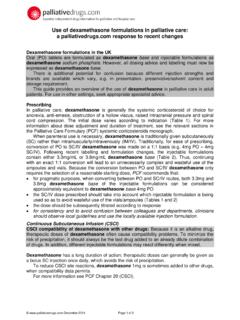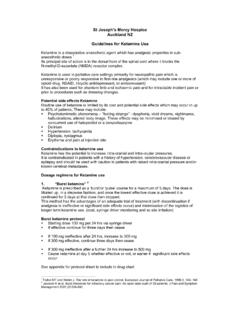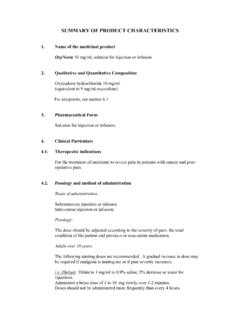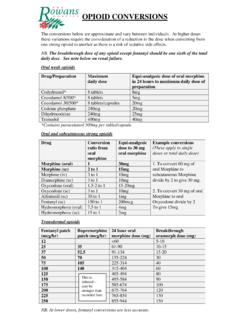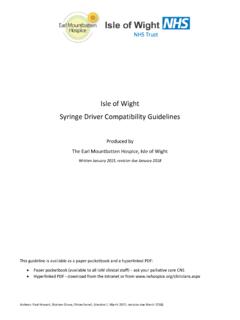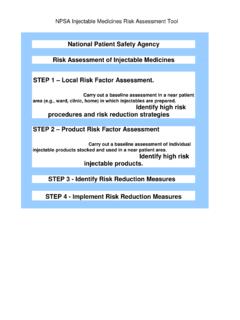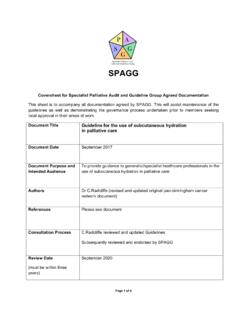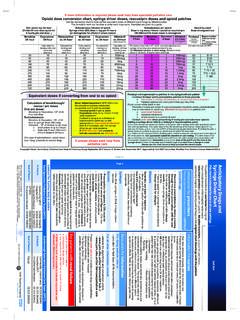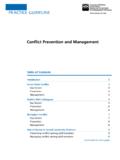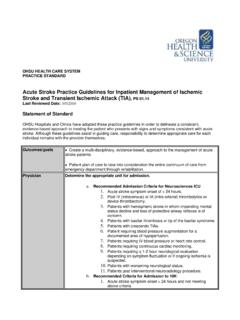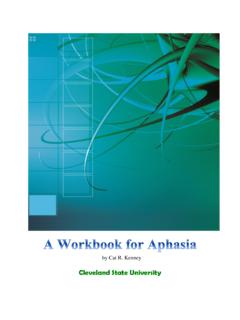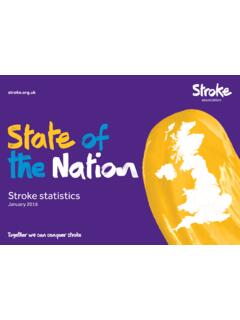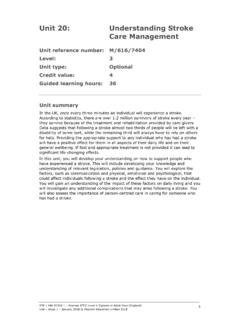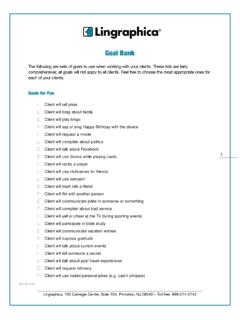Transcription of Guidelines for the management of Seizures
1 Seizures Guidelines Revision No. 2 Approved by: ND/MMG Date of Approval: June 2015 Date of Implementation: Page 1 of 9 Revision due by: June 2017 Guidelines for the management of Seizures Amalgamation and update of previous policies 7 (Seizure Guidelines , ND, 2015) and 9 (Status epilepticus, KJ, 2011) Seizures can occur in up to 15% of the Palliative Care population. Of these 25-50% will have brain metastases. In the case of patients with primary brain tumours, 30% initially present with a seizure. Seizures are more common in patients with low grade brain tumours and tumours involving the motor cortex and meninges. Many patients with primary brain tumours or brain metastases may never have a seizure and so the risks of medication for seizure prophylaxis will outweigh any benefits. These Guidelines help to address in which patient s seizure prophylaxis should be commenced and which anticonvulsants may be most appropriate.
2 Aetiology of Seizures In our patients the cause of Seizures can be broadly divided into structural and systemic causes. Structural causes include: Systemic causes include: Primary Brain Tumour Hyponatraemia Brain Metastases Uraemia Brain Abscess Hypoglycaemia Bleeding Hepatic Failure Radiation Necrosis Hypoxia Medications Systemic Infection Drugs as a cause of Seizures There are a number of ways in which drugs could be implicated in seizure activity. These include; Drug withdrawal including benzodiazepines, alcohol. Unable to take usual anticonvulsant secondary to vomiting, poor swallow, drowsiness. New drug interacting with usual anticonvulsant E. g. dexamethasone and phenytoin. New medications in patients without a history of Seizures including antidepressants, antipsychotics (haloperidol, levomepromazine) and tramadol.
3 Also, certain chemotherapy agents including paclitaxel and ifosfamide, can cause Seizures Differential Diagnoses These include post syncope events, rigors, myoclonic jerks (eg from morphine or gabapentin) and tardive dyskinesias. Seizures Guidelines Revision No. 2 Approved by: ND/MMG Date of Approval: June 2015 Date of Implementation: Page 2 of 9 Revision due by: June 2017 Classification of Seizures In recent years the classification system for Seizures has been reviewed. This is in part based on neuroimaging findings which may be less relevant to us in palliative care, however it remains important for us to classify Seizures in order to aid diagnosis and management . Seizures are initially classified as focal or generalized, then further classified depending on their clinical features. Assessment 1.
4 FOCAL ( Seizures originate in one hemisphere of the brain)Awareness may be altered OR retainedMotor FeaturesIncreased or decreased motor contractions (automatisms/ atonia)Sensory Features(aura)Autonomic Features (eg nausea,vomiting, pallor, tachycardia)2. GENERALISED(Involves different areas on both sides of the brain from the outset)Associated with impaired consciousnessTonic-Clonic (convulsive)Tonic (increased tone and falls)Clonic (regular jerking of arm, neck, face)Myoclonic (irregular jerking of limbs)Atonic (sudden loss of muscle tone)Absence (loss of awareness) Seizures Guidelines Revision No. 2 Approved by: ND/MMG Date of Approval: June 2015 Date of Implementation: Page 3 of 9 Revision due by: June 2017 Following a seizure, a full history and examination should be performed. Consider checking bloods and transferring for neuroimaging if appropriate.
5 Patients who have a reversible (non-structural) cause of their Seizures should have this treated, therefore anticonvulsant therapy is unlikely to be required. Initially, high dose dexamethasone and referral for brain radiotherapy should be considered for patients with brain metastases, in addition to an anticonvulsant (see below). Anticonvulsant Therapy Patients with a likely irreversible structural cause for their Seizures should be commenced on a long-term anticonvulsant following their first seizure, as their risk for a further seizure will persist. There is no evidence for their routine prophylactic use. By definition, patient s with a structural brain lesion are likely to have focal Seizures (but may well progress rapidly to a generalized tonic-clonic seizure) so will respond to broad spectrum anticonvulsants.
6 Choice of anticonvulsant This will be an individual decision for each patient dependent on; Side effect profile Comorbid conditions Interactions with other medications Many anticonvulsants are enzyme inducing drugs. These are best avoided in our patient population because of their interaction with other medications, particularly chemotherapy, benzodiazepines and steroids. Enzyme inducing anticonvulsants include; Phenytoin Carbamazepine Topiramate Phenobarbital Oxcarbazepine It is preferable to use monotherapy for control of Seizures and to gradually titrate the dose as far as tolerated or until the patient is seizure free. Around 60% of patients will be controlled on the first line anticonvulsant, others may need to try second line medication (there is likely to need to be a cross over period). Seek specialist neurological advice should monotherapy fail.
7 Seizures Guidelines Revision No. 2 Approved by: ND/MMG Date of Approval: June 2015 Date of Implementation: Page 4 of 9 Revision due by: June 2017 Options for first line anticonvulsants Sodium Valproate Indicated for the treatment of focal or generalized Seizures . Crushable, so may be preferable in patients with a PEG/ RIG. Always prescribe the MR form. Generally well tolerated and can titrate rapidly. Not licensed for SC use however there are reports of using IV Sodium Valproate sub-cutaneously without ill effects. The ratio PO:SC is 1:1. Can also be useful if concurrent neuropathic pain. Lamotrigine Indicated for the treatment of focal or generalized Seizures . Is usually well tolerated in the elderly as it has a favorable cognitive and behavioral profile. However it can worsen myoclonic jerks and cause insomnia.
8 The half-life of lamotrigine is prolonged by sodium valproate. Alternative anticonvulsants Levetiracetam Licensed for the monotherapy of focal Seizures . Side effects can include low mood or behavioral disturbances. Not licensed for SC use but reports do show that it is being used via a syringe driver (or BD boluses), with good effect. The ration PO:SC -1:1 (see acute seizure management Guidelines below). Clobazam May be useful to gain control if there are clusters of Seizures . Pregabalin/ Gabapentin Seizures Guidelines Revision No. 2 Approved by: ND/MMG Date of Approval: June 2015 Date of Implementation: Page 5 of 9 Revision due by: June 2017 Pregabalin is more effective than gabapentin at controlling (focal) Seizures . Also useful if concurrent neuropathic pain. Non Pharmacological Considerations Seizures are frightening and distressing for both patients and their carers.
9 Treatment should include education of the patient and their family as to the cause and ongoing management of the Seizures . Potential problems (eg drug interactions and the risk of Seizures if the patient is unable to take oral anticonvulsants) need to also be discussed. Advance Care Planning discussions should be had with the patient and anticipatory medications be available in the home. Anticonvulsants in the terminal phase Patients should continue oral anticonvulsants as long as they are able to swallow. Once they are unable to swallow the regular medication should be substituted with Midazolam 30mg/24 hours CSCI. Seizures Guidelines Revision No. 2 Approved by: ND/MMG Date of Approval: June 2015 Date of Implementation: Page 6 of 9 Revision due by: June 2017 Acute management of Seizures and Status Epilepticus (SE) If patient appropriate to transfer to hospital, call 999 and follow steps 1-4 Check airway, safe positioning, check blood sugar ( +/- give oxygen) Midazolam 10mg SC bolus Repeat in 10 minutes if not effective If IV access 2-4mg lorazepam bolus.
10 Can repeat in 10 minutes if needed If still seizing (SE) and patient not appropriate for hospital Phenobarbitone 200-800mg IM stat ** (can repeat after 30 mins) Start CSCI: 1) 30 -100mg midazolam/24 hours or 2) 800-1200mg phenobarbitone/24 hours or 3) Consider levetiracetam (see below) or 4) A combination -Further stats of midazolam or phenobarbitone as needed. -Can give IV or SC phenobarbitone instead of IM but must be diluted 1:10 with water and given no quicker than 100ml/min. SC bolus cannot be used (irritant) -A levetiracetam CSCI can be used either if the patient was on the oral form anyway (ratio PO:SC is 1:1) or if you don t want the patient to be too sedated.

